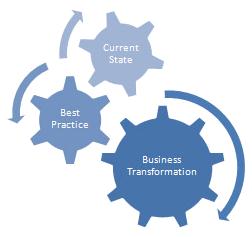Business Process Change and CRM
John Eccles, 08 September 2011
 Processes are at the heart of any businesses. These processes need to change in order to be more productive and more competitive. CRM can be a part of that change. The principles of Business Process Redesign can be applied to the design of CRM and XRM systems.
Processes are at the heart of any businesses. These processes need to change in order to be more productive and more competitive. CRM can be a part of that change. The principles of Business Process Redesign can be applied to the design of CRM and XRM systems.
Principles of Process Redesign
The following theory and principles are taken from chapter 3 of “Redesigning Enterprise Processes for e-Business, El Sawy, Omar A. (2001)”
Principle #0: Remove waste, simplify and consolidate similar activities.
This is common-sense management that should be the starting point of any change to Business Processes. For a CRM system, this principle implies that we should minimize clicks, minimize number of screens and remove unnecessary information from the screen.
Fundamental Approaches 
There are three fundamental approaches to improving Business Processes outlined by El Sawy:
1. Restructure and reconfigure the processDo things in different ways in order to be faster and/or more flexible and/or more efficient. For example, change from a batch process to a continuous process.
2. Change the information flows around the processCollect information once and make it available as required. Provide the right information at the time it is needed in the process.
3. Change knowledge management around the processAs the process runs, information can be collected and used to be more effective.
The 10 Principles of Business Process Redesign
These approaches can be further divided into 10 principles and each principle can help us with a CRM or XRM system:
| Principle | Application to CRM/XRM |
| 1. Lose Wait
Eliminate or reduce waiting time in a process. In traditional processes, products and services are receiving value added only 5% of the time! | Make processes faster |
| 2. Orchestrate
Partner with other enterprises to utilize their skill or speed of execution | Facility to integrate with other software at other enterprises |
| 3. Mass-Customize
Flex the process for any time, any place, any way | Provide 24/7 customer access via a web portal |
| 4. Synchronize
Synchronize the physical and virtual parts of the process | Integrate with bar-code scanners to track physical movement of products through a process. |
| 5. Digitize and Propagate
Capture information digitally at the source and propagate it through the process | Shift data-entry to customers where possible |
| 6. Vitrify
Provide process transparency through fresher and richer information about the status of the process | Provide on-demand tracking information for customers – perhaps via a web-portal |
| 7. Sensitize
Fit the process with the means to feed-back problems and changes
| Provide a means for customers to comment on the process – perhaps via a web portal or perhaps a response to a system-generated SMS message |
| 8. Analyse and Synthesize
Provide interactive analysis and synthesis capabilities around the process to generate value added | Dashboards that provide “slice and dice” data analysis capabilities to detect patterns |
| 9. Connect, Collect and Create
Grow intelligently reusable knowledge around the process through all who touch it | Provide a forum or knowledge sharing spaces for process users to communicate and learn from each other’s experience |
| 10. Personalize
Make the process intimate with the preferences and habits of participants | Record preferences of customers |
These are just some of the applications to CRM / XRM systems that came to mind. Any further ideas would be appreciated.

